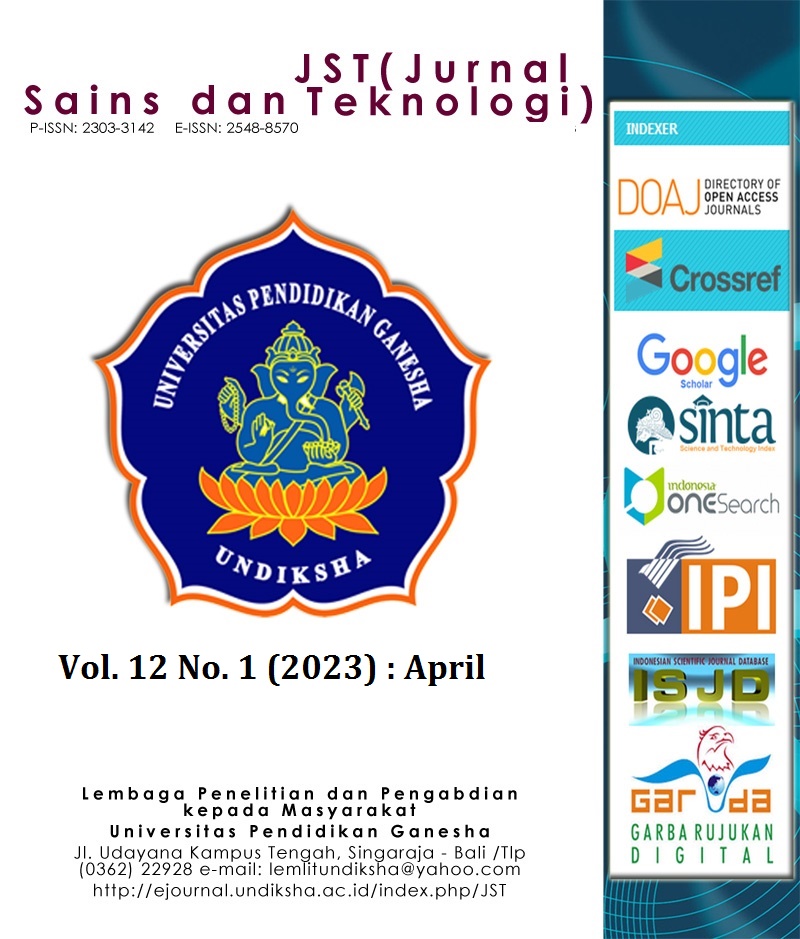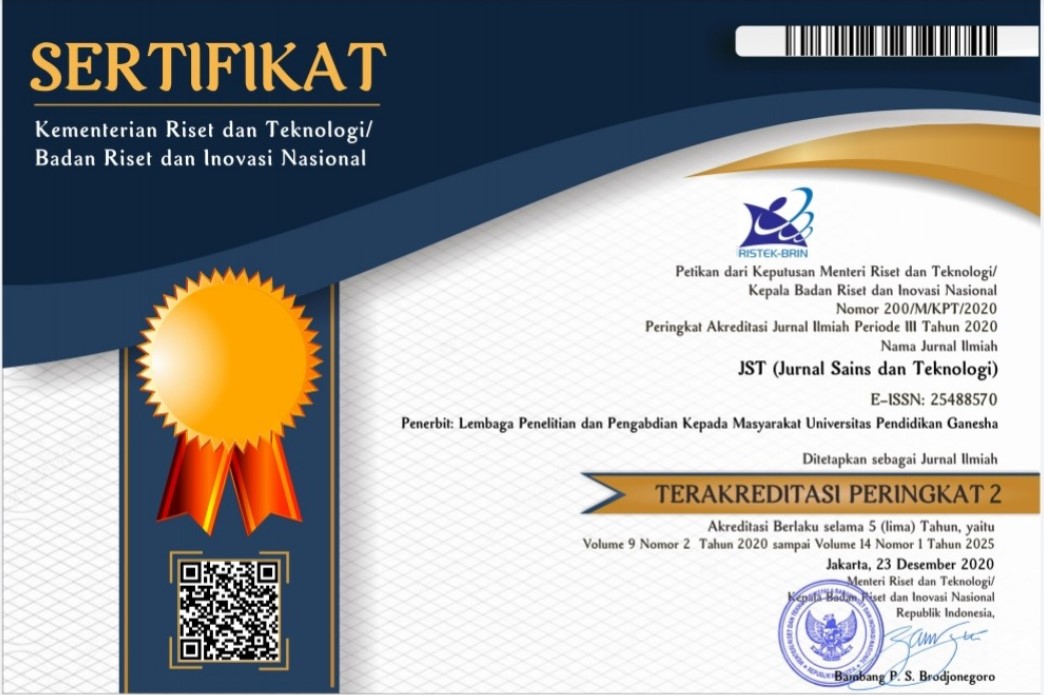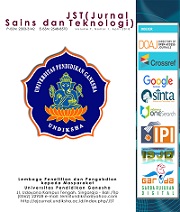Alat Ukur Parameter Fisik Inkubator Bayi : Suhu, Kelembaban, Aliran Udara dan Tingkat Kebisingan
DOI:
https://doi.org/10.23887/jstundiksha.v12i1.40855Keywords:
Incubator Analyzer, Temperatur, Kelembaban, Kecepatan Aliran Udara, Tingkat KebisinganAbstract
Incubator Analyzer merupakan alat untuk mengukur parameter-parameter fisis yang terdapat pada alat inkubator bayi dengan tujuan memverifikasi nilai keluaran alat sehingga menjamin keselamatan alat untuk layanan pasien. Saat ini telah tersedia beberapa penyedia alat kalibrasi inkubator bayi di Indonesia, namun ketersediaan produk ini masih di impor dengan harga produk yang relatif mahal. Sehingga pada artikel ini dilaporkan purwarupa alat ukur parameter fisis inkubator bayi untuk mendukung program kemandirian produk dalam negeri. Metode yang dilakukan pada penelitian ini merupakan metode eksperimen dalam merancang dan mengembangkan alat ukur parameter inkubator bayi dengan memaksimalkan ketersediaan komponen di pasar lokal. Adapun perancangan alat mengacu pada SNI IEC 60601-2-19-2014 yang merupakan standar persyaratan khusus untuk keselamatan dasar dan kinerja esensial incubator infant, dengan parameter yang diukur terdiri dari pengukuran temperatur udara ruang inkubator, temperatur matras, kelembaban, kecepatan aliran udara dan tingkat kebisingan. Desain pengukuran temperature menggunakan resistive temperature detector PT 100, SHT 11 sebagai sensor kelembaban, GFS131 sebagai sensor aliran udara, MAX4466 merupakan microphone amplifier sebagai sensor suara, serta LCD TFT nextion 3,5” sebagai tampilan. Purwarupa ini juga dilengkapi sistem baterai isi ulang sebagai catu daya portable. Pengujian alat dilakukan dengan membandingkan hasil yang terbaca oleh alat yang dirancang dengan alat Incu Analyzer II Fluke Biomedical. Hasilnya menunjukkan purwarupa alat ukur parameter inkubator bayi mampu membaca nilai suhu, kelembaban, kecepatan aliran udara, dan tingkat kebisingan di dalam chamber inkubator bayi. Nilai keakurasian pengukuran parameter suhu mencapai lebih dari 98%, sehingga purwarupa ini memiliki potensi untuk dilakukan pengujian produk pada lembaga berwenang.
References
Altayyar Saleh, S., Mousa, M. A., Alfaifi, A. M., Negm, A. E., & Ali, M. O. (2018). The impact of calibration on medical devices performance and patient safety. Biomedical Research (India), 29(12), 2553–2560. https://doi.org/10.4066/biomedicalresearch.29-18-550.
Athavale, V. A., Pati, A., Hossain, A. K. M. B., & Luthfiyah, S. (2022). An Android INCU Analyzer Design to Calibrate Infant Incubator Using Bluetooth Communication for Real-Time and Wireless Monitoring. 15(1), 1–8. https://doi.org/10.35882/teknokes.v15i1.1.
Azkiyak, V. N., Syaifudin, S., & Titisari, D. (2020). Incubator Analyzer Using Bluetooth Android Display (Humidity & Air Flow). Indonesian Journal of Electronics, Electromedical Engineering, and Medical Informatics, 1(2), 71–77. https://doi.org/10.35882/ijeeemi.v1i2.5.
Badan Standarisasi Nasional. (2014). SNI IEC 60601-2-19:2014 : Persyaratan khusus untuk keselamata dasar dan kinerja esesensial inkubator infant.
Bess, F. H., & Bess, H. (2015). Observations on Noise Levels in Infant Incubators. July. https://doi.org/10.1542/peds.63.1.100.
Chowdhury, M. R. (2012). General Concept of Calibration. International Journal of Pharmaceutical and Life Sciences, 1(3), 2305. https://doi.org/10.3329/ijpls.v1i3.12981.
Ferris, T. K., & Shepley, M. M. (2013). The design of neonatal incubators: A systems-oriented, human-centered approach. Journal of Perinatology, 33(SUPPL. 1), 24–31. https://doi.org/10.1038/jp.2013.11.
Golpaygani, T. (2019). Journal of Biomedical Physics and Engineering. 251–256. https://doi.org/10.31661/jbpe.v0i0.761.
Latif, A., Widodo, H. A., Atmoko, R. A., Phong, T. N., & Helmy, E. T. (2021). Temperature and humidity controlling system for baby incubator. Journal of Robotics and Control (JRC), 2(3), 190–193. https://doi.org/10.18196/jrc.2376.
Ningtias, D. R., Wahyudi, B., & Harsoyo, I. T. (2021). Monitoring Suhu pada Infant Warmer Menggunakan INCU Analyzer Berbasis Arduino. Elektrika, 13(1), 22. https://doi.org/10.26623/elektrika.v13i1.3118.
OMBUDSMAN. (2018). Kalibrasi Alat Kesehatan Dalam Rangka Peningkatan Pelayanan Kesehatan Publik di Puskesmas (p. 12).
Ozdemİrcİ, E., Özarslan Yatak, M., Duran, F., & Canal, M. R. (2014). Reliability assessments of infant incubator and the analyzer. Gazi University Journal of Science, ISBN: 27(4), 1169–1175.
Restin, T., Gaspar, M., Bassler, D., Kurtcuoglu, V., Scholkmann, F., & Haslbeck, F. B. (2021). Newborn incubators do not protect from high noise levels in the neonatal intensive care unit and are relevant noise sources by themselves. Children, 8(8). https://doi.org/10.3390/children8080704.
Saleh, A. R. (2013). Mengenal ICS Sebagai Salah Satu Sistem Klasifikasi Dokumen. Media Pustakawan, 20(1), 5–8. https://ejournal.perpusnas.go.id/mp/article/view/895.
Samputri, H. N. A., Syaifudin, S., & Titisari, D. (2019). Incubator Analyzer Menggunakan Aplikasi Android. Jurnal Teknokes, 12(1), 14–20. https://doi.org/10.35882/teknokes.v12i1.3.
Sen, G. T., & Yuksekkaya, M. (2018). Desing and Test of an Incubator Analyzer. ISMSIT 2018 - 2nd International Symposium on Multidisciplinary Studies and Innovative Technologies, Proceedings, 2–6. https://doi.org/10.1109/ISMSIT.2018.8567049.
Sensirion. (2004). Humidity & Temperature Sensor. 1–9.
Syarifatul Ainiyah, Andayani, D. H., Pundji, A., & Shaib, M. (2020). Development of Incubator Analyzer Based on Computer with Temperature And Humidity Parameters. Journal of Electronics, Electromedical Engineering, and Medical Informatics, 2(2), 48–57. https://doi.org/10.35882/jeeemi.v2i2.3.
Vasilevskyi, O. M. (2014). Calibration method to assess the accuracy of measurement devices using the theory of uncertainty. International Journal of Metrology and Quality Engineering, 5(4). https://doi.org/10.1051/ijmqe/2014017.
Wijaya, R. A., Lestari, S. W. L. W., & Mardiono, M. (2019). Rancang Bangun Alat Monitoring Suhu dan Kelembaban Pada Alat Baby Incubator Berbasis Internet Of Things. Jurnal Teknologi, 6(1), 52. https://doi.org/10.31479/jtek.v6i1.5.
Wongkamhang, A., Phasukkit, P., Pintuviroj, C., Prasantamrongsiri, S., Sanpanich, A., & Thongpance, N. (2013). Design and Simulation of Air Flow Inside Double Study for Multi Inflow and Outflow Slot . 3–6. https://doi.org/10.1109/BMEiCon.2013.6687694.
Zacarías, F. F., Jiménez, J. L. B., Velázquez-gaztelu, P. J. B., Molina, R. H., & López, S. L. (2018). Noise level in neonatal incubators: A comparative study of three models. International Journal of Pediatric Otorhinolaryngology. https://doi.org/10.1016/j.ijporl.2018.02.013.
Downloads
Published
How to Cite
Issue
Section
License
Copyright (c) 2022 JST (Jurnal Sains dan Teknologi)

This work is licensed under a Creative Commons Attribution-ShareAlike 4.0 International License.
Authors who publish with the Jurnal Sains dan Teknologi (JST) agree to the following terms:
- Authors retain copyright and grant the journal the right of first publication with the work simultaneously licensed under a Creative Commons Attribution License (CC BY-SA 4.0) that allows others to share the work with an acknowledgment of the work's authorship and initial publication in this journal.
- Authors are able to enter into separate, additional contractual arrangements for the non-exclusive distribution of the journal's published version of the work (e.g., post it to an institutional repository or publish it in a book), with an acknowledgment of its initial publication in this journal.
- Authors are permitted and encouraged to post their work online (e.g., in institutional repositories or on their website) prior to and during the submission process, as it can lead to productive exchanges, as well as earlier and greater citation of published work. (See The Effect of Open Access)
















